Catalyzing change, fueling sustainable economic growth

Catalysts accelerate the reactions that will transform the Kingdom’s chemical sector. By advancing environmental sustainability and industrial development through catalysis innovation, KAUST supports Saudi Vision 2030 economic diversification and sustainability goals, enabling more efficient, cost-effective processes that benefit the entire world.
“We’re investigating how to make industry circular and sustainable,” said KAUST Professor Javier Ruiz Martinez, Chemical Engineering. “For example, we’re exploring ways to chemically recycle plastic waste or convert carbon dioxide into valuable products such as fuels or specialty chemicals. These are major research areas at KAUST.”
According to Ruiz-Martinez, co-chair of the “KAUST Research Conference: Catalyzing the Energy and Chemical Transition Toward Circularity,” about 85 percent of chemicals currently in use go through at least one catalytic process, and nearly all fuels rely on catalytic reactors. KAUST President Sir Edward Byrne AC told conference attendees that catalysts are one example of how the University is at the forefront of scaling transition innovation.
“KAUST is building robust platforms to accelerate the journey from laboratory to market with many collaborators. We focus on use-inspired science and innovation ecosystems and are determined to serve as a convener of knowledge, talent, and industry,” he said, adding that KAUST is advancing hydrogen technology and CO2 utilization via tandem catalysis, electrochemical pathways, and thermocatalytic innovations — all areas of interest within the Kingdom.
“We are helping position Saudi Arabia as a global hub for hydrogen innovation. At KAUST, our role is to serve as both a generator of knowledge and a bridge to deployment.”
Fellow event co-chair Professor Pedro Castaño, Chemical Engineering, said catalysis is foundational to converting waste and raw materials into sustainable, high-value products, positioning Saudi Arabia as a global exporter of clean energy and chemicals. “I strongly believe catalysis plays a vital role not only in revamping existing infrastructure, but also in designing new processes that enable a sustainable transition.”
Driving sustainable innovation
Heterogeneous catalysis is particularly crucial for producing fuels and chemicals essential to modern society, said Ruiz-Martinez. Using solid catalysts with gaseous or liquid reactants makes it easier to separate, reuse, and recycle expensive solid catalysts, improving efficiency and cost-effectiveness, especially in industrial-scale applications.
“KAUST recognized early on the importance of catalysis. That’s why, when the University was founded, a dedicated catalysis center was created. It has since evolved into a full platform, and we now have several teams working across different types of catalysis — not just heterogeneous, but also homogeneous and others.”
For Ruiz-Martinez, his main research goal is to design new catalysts that can convert sustainable feedstocks — such as CO2 or waste — into valuable chemicals. These feedstocks are different from traditional ones, such as crude or natural gas, so his team must completely rethink catalyst design. “The idea is to make catalysts that aren’t just effective in the lab, but also scalable and ready for real-world industrial applications. That’s where I’m focusing my efforts.”
He added: “A lot of our work is about taking alternative feedstocks — things such as biomass, waste, or even CO2 — and converting them into fuels and chemicals.”
Castaño focuses on application and advancing the technological readiness of catalytic solutions, working to bridge the gap to real-world deployment. He tests catalytic materials under industrially relevant conditions, using reactors that simulate actual operations and account for challenges such as feed impurities and catalyst poisons.
“We aim to understand the full set of phenomena happening in industrial reactors, not just catalysis. That helps us develop the tools that industry needs to scale up these processes. As a university, we’re not building full conversion systems like companies would, but we can provide the critical data and methodologies to support that transition.”
KSA priorities
There is a strong push toward national industrialization, Ruiz-Martinez noted, and KAUST’s research facilitates the development of viable catalytic processes for in-Kingdom implementation. For example, at NEOM, which aims to produce hydrogen and sustainable chemicals such as ammonia, catalysis technology plays a central role.
Within the traditional energy sector, he said, KAUST is working with key stakeholders to find new ways to utilize hydrocarbons through catalysis technology. “Traditionally, oil has been used to produce fuels, which we then burn — releasing CO2. But what if we instead convert oil into chemicals? Those chemicals can be recycled, which helps reduce emissions. That’s one of the ways we’re helping the petrochemical sector evolve into a more sustainable model.”
The set of “incredible catalysts” for many processes is growing, noted Castaño, from traditional ones to fully sustainable systems using CO2, photons and more. However, he said, bringing those to market requires many steps — especially engineering-related ones — that must be addressed. “These are exactly the aspects my group tackles.”
KAUST is developing new catalytic processes, especially with a focus on sustainability — a major theme of the recent conference, Ruiz-Martinez added. KAUST research transforms alternative feedstocks into fuels and chemicals, with catalysis crucial to Saudi Arabia achieving its 2060 net-zero emissions aspirations. “We need new catalytic materials and reactor designs to convert sustainable feedstocks into chemicals efficiently.”
Impactful research
Ruiz-Martinez and Castaño organized the three-day catalysis conference, uniting leading minds in academia and industry from across the Kingdom and worldwide to discuss the future of catalysis and catalytic reactors. Ruiz-Martinez said: “We’re creating opportunities for meaningful partnerships that align with both KAUST’s goals and national priorities.”
KAUST faculty also showcased research during the conference. Professor Xu Lu, Chemical Engineering, discussed electrochemical conversion of high-pressure CO2, stressing the need for practical engineering solutions and integration of material science into real-world models. He highlighted Saudi Arabia’s substantial investments into carbon capture, emphasizing KAUST’s efforts to economically and sustainably utilize this resource that would otherwise be wasted.
Chemistry Professor Yoji Kobayashi presented on the management of electrons and anions in the solid state for catalysis. Kobayashi’s research focuses on new or previously unexamined materials, which may offer unique catalytic mechanisms. He also discussed ongoing work with the KAUST catalysis experts on reactions involving oxygen, such as methane oxidation, to further expand catalytic applications.
Meanwhile, Professor Carlos Grande, Chemical Engineering, discussed 3D printing as an enabling tool for process intensification of reactors, noting its potential as a transformational tool while emphasizing the importance of selecting the right applications. He described the need for chemical engineers to learn more geometry to effectively design for 3D printing, stressing that this new manufacturing technique could revolutionize chemical engineering.
Research scientist Dr. Enrique V. Ramos Fernández highlighted KAUST’s work to advance photothermal catalysts for sustainable chemistry, exploring how light can heat the catalyst while also controlling its active phase. By managing heat distribution, researchers aim to enhance catalytic activity and enable dynamic phase switching. Castaño added that focusing on catalyzing sustainable development comes at a critical time shaped by global political and strategic shifts.
“Of course, we need the thrust from companies, which was clear from the interactions we had with the industry colleagues who participated, but at the same time we also need policymakers,” he said, highlighting the key role of researchers in proving the technological readiness of solutions to the public. “Some of these chemistries or processes require the help of governments to facilitate or catalyze the initial tests at higher scales.”
Collaboration matters

Catalysis experts from around the world converge at KAUST for the KAUST Research Conference: Catalyzing the Energy and Chemical Transition Toward Circularity, April 28-30.
Although the conference facilitated direct connections between KAUST catalysis researchers and universities and companies from around the world, Ruiz-Martinez noted that KAUST catalysis experts are already active collaborators with major industry players such as BASF, Dow Chemicals, TotalEnergies, Umicore, Aramco, and SABIC.
“We’re very active in collaborations — both inside and outside the Kingdom. For example, my own research focuses on understanding catalyst materials to enable rational design, and for that, we partner with international synchrotron facilities that allow us to do advanced material characterization.”
He added: “We collaborate with the Swiss Light Source in Zurich, the European Synchrotron Radiation Facility in Grenoble, and synchrotrons in Hefei, China. These partnerships are crucial to advancing our understanding of catalysts at the molecular level.”

